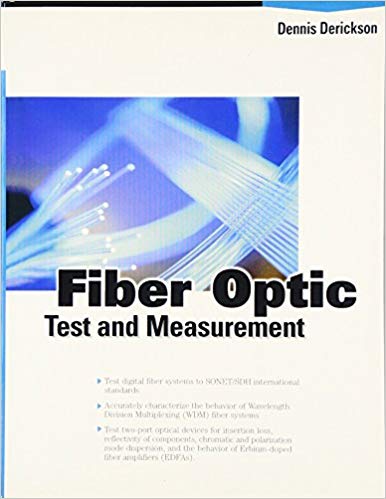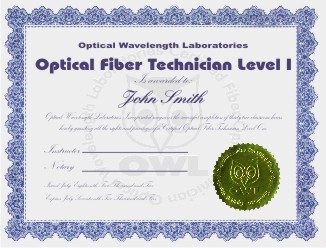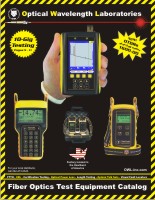| OPTICAL WAVELENGTH LABORATORIES TRAINING COURSES |
 COURSE NAME: FIBER OPTICS FOR THE TECHNICIAN
COURSE NAME: FIBER OPTICS FOR THE TECHNICIAN
The course instructor, Dan Welch, has been involved with datacomm and cabling since the early 1980’s. Dan is currently the chief engineer at Optical Wavelength Laboratories which involves him with the design of a complete line fiber optic test equipment. Dan’s many accomplishments include his assistance in the development of satellite to US Navy submarine communications systems. Dan’s career has included training university and information technology personnel in the field of telecommunications. More ... |
 COURSE NAME: FIBER OPTIC TEST AND MEASUREMENT COURSE NAME: FIBER OPTIC TEST AND MEASUREMENTThe course instructor, Dan Welch, has been involved with datacomm and cabling since the early 1980’s. Dan is currently the chief engineer at Optical Wavelength Laboratories which involves him with the design of a complete line fiber optic test equipment. Dan’s many accomplishments include his assistance in the development of satellite to US Navy submarine communications systems. Dan’s career has included training university and information technology personnel in the field of telecommunications. More... |
|
PART ONE - BACKGROUND
CLASSROOM TIME: 8 hours Ch. 1- The Communications Revolution Ch. 2 - Information Transmission Ch. 3 - Fiber Optics as a Communications Medium: Its Advantages Ch. 4 - Light PART TWO - FIBER-OPTIC COMPONENTS CLASSROOM TIME: 16 hours Ch. 5 - The Optical Fiber Ch. 6 - Fiber Characteristics Ch. 7 - Fiber-Optic Cables Ch. 8 - Sources Ch. 9 - Detectors Ch. 10 - Transmitters and Receivers Ch. 11 - Connectors and Splices Ch. 12 - Couplers PART THREE - FIBER-OPTIC SYSTEMS CLASSROOM TIME: 8 hours Ch. 13 - The Fiber-Optic Link Ch. 14 - Fiber-Optic Cable Installation and Hardware Ch. 15 - Fiber-Optic Systems and Applications Ch. 16 - Introduction to Test and Other Equipment |
UNIT 1: Introduction to Fiber Optic Systems and Measurement 1.1 -- Introduction 1.2 -- Fiber Optic Links: The Basics 1.3 -- Digital Communications Links 1.4 -- Wavelength Division Multiplexed Systems 1.5 -- Analog Links 1.6 -- Characterization of Digital Fiber-Optic Links 1.7 -- Optical Fibers and Two-Part Optical Components 1.8 -- Measurement of Optical Fiber and Two-Part Optical Components 1.9 -- Optical Transmitters 1.10 -- LEDs 1.11 -- Optical Receivers 1.12 -- Optical Transmitter and Receiver Measurements Appendix: Relationships Between Wavelength and Frequency UNIT 2: Optical Power Measurement 2.1 -- Introduction 2.2 -- Power Meters with Thermal Detectors 2.3 -- Power Meters with Photodetectors 2.4 -- Absolute Power Measurement 2.5 -- Responsivity Calibration 2.6 -- Linearity Calibration 2.7 -- Summary UNIT 3: Optical Spectrum Analysis 3.1 -- Introduction to Optical Spectrum Analysis 3.2 -- Types of Optical Spectrum Analyzers 3.3 -- Anatomy of a Diffraction-Grating-Based Optical Spectrum Analyzer 3.4 -- Operation and Key Specifications of Diffraction-Grating-Based Optical Spectrum Analyzers 3.5 -- Spectral Measurements on Modulated Signals 3.6 -- OSA Application Examples 3.7 -- Summary UNIT 4: Wavelength Meters 4.1 -- Introduction 4.2 -- The Michelson Interferometer Wavelength Meter 4.3 -- Wavelength Meters in Multiple Signal Environments 4.4 -- Absolute Wavelength Accuracy Considerations for Michelson-Interferometer Wavelength Meters 4.5 -- Michelson Wavelength-Meter Measurement Considerations 4.6 -- Alternate Wavelength Meter Techniques 4.7 -- Summary UNIT 5: High Resolution Optical Frequency Analysis 5.1 -- Introduction 5.2 -- Basic Concepts 5.3 -- Laser Linewidth Characterization 5.4 -- Optical Spectral Measurement of a Modulated Laser 5.5 -- Laser Chirp Measurement 5.6 -- Frequency Modulation Measurement 5.7 -- Summary UNIT 6: Polarization Measurements 6.1 -- Introduction 6.2 -- Polarization Concepts 6.3 -- Retardance Measurement 6.4 -- Measurement of Cross-Talk in Polarization-Maintaining Fiber 6.5 -- Summary UNIT 7: Intensity Modulation and Noise Characterization of Optical Signals 7.1 -- Modulation Domain Analysis 7.2 -- Modulation Transfer Function 7.3 -- Modulation Signal Analysis 7.4 -- Intensity Noise Characterization 7.5 -- Modulation Domain Calibration Techniques UNIT 8: Analysis of Digital Modulation on Optical Carriers 8.1 -- Digital Fiber-Optic Communications Systems 8.2 -- Bit-Error Ratio 8.3 -- Eye-Diagram Analysis 8.4 -- Mask Measurements 8.5 -- Jitter Testing UNIT 9: Insertion Loss Measurements 9.1 -- Introduction 9.2 -- How the Component Influences the Measurement Technique 9.3 -- Single-Wavelength Loss Measurements 9.4 -- Uncertainties of Single-Wavelength Loss Measurements 9.5 -- PDL Measurement 9.6 -- Introduction to Wavelength-Dependent Loss Measurements 9.7 -- Wavelength-Dependent Loss Measurements Using a Tunable Laser 9.8 -- Wavelength-Dependent Loss Measurements Using a Broadband Source 9.9 -- Summary UNIT 10: Optical Reflectometry for Component Characterization 10.1 -- Introduction 10.2 -- Total Return Loss Technique 10.3 -- Basic Concepts for Spatially Resolved Reflectometry 10.4 -- Optical Low Coherence Reflectometry 10.5 -- Survey of Different Techniques 10.6 -- Comparison of Techniques UNIT 11: OTDRs and Backscatter Measurements 11.1 -- Introduction 11.2 -- Principle of OTDR Operation 11.3 -- Fiber Loss, Scatter, and Backscatter 11.4 -- Measuring Splice- and Connector Loss 11.5 -- Return Loss and Reflectance 11.6 -- Automated Remote Fiber Testing 11.7 -- Outlook UNIT 12: Dispersion Measurements 12.1 -- Introduction 12.2 -- Measurement of Intermodal Dispersion 12.3 -- Measurement of Chromatic Dispersion 12.4 -- Polarization-Mode Dispersion 12.5 -- Summary UNIT 13: Characterization of Erbium-Doped Fiber Amplifiers 13.1 -- Fiber Amplifiers 13.2 -- Gain 13.3 -- Noise 13.4 -- Noise Figure 13.5 -- Characterization of Gain and Noise Figure 13.6 -- Other Types of Optical Amplifiers 13.7 -- Sources of Measurement Errors 13.8 -- Useful Constants for EDFA Measurements 13.9 -- Summary Appendix A: Noise Sources in Optical Measurements A.1 -- Electrical Thermal Noise A.2 -- Optical Intensity Noise A.3 -- Photocurrent Shot Noise A.4 -- Optical-Phase-Noise to Intensity-Noise Conversion A.5 -- Summary Appendix B: Nonlinear Limits for Optical Measurements B.1 -- Raman Limit B.2 -- Self-Phase Modulation B.3 -- Brillouin Limit B.4 -- Summary Appendix C: Fiber Optic Connectors and Their Care C.1 -- Background C.2 -- Connector Styles C.3 -- Connector Design C.4 -- Connector Care C.5 -- Cleaning Procedures |
 ABOUT THE TEXT ABOUT THE TEXT Pages: 345 SYNOPSIS An excellent primer for students beginning to study the subject, there is equal emphasis on both the theory of fiber and its applications in communications. There is a thorough explanation and description of how fiber differs from copper wire as well as a useful perspective on how fiber is used. ANNOTATION Provides an introduction to fiber optic technology for communications, covering the fundamentals in a precise style. Includes an expanded coverage of broadband systems, a clear writing style that makes concepts easy to grasp, and a practical orientation of material that provides valuable perspectives on uses of fiber optics. FROM THE PUBLISHER This concise, current text provides an introduction to fiber optic technology for communications, covering the fundamentals in a precise style. An excellent primer for students beginning to study the subject, there is equal emphasis on both the theory of fiber and its applications in communications. There is a thorough explanation and description of how fiber differs from copper wire as well as a useful perspective on how fiber is used. |
 ABOUT THE TEXT ABOUT THE TEXT
Pages: 642 SYNOPSIS The complete, practical guide to testing fiber optic communication components and systems. Fiber optic networks are evolving rapidly—and so is the technology used to design, measure, and test them. Fiber Optic Test and Measurement is the first authoritative, complete guide to measuring both current optical networks and those on the horizon. It reflects the collective experience of Hewlett-Packard's world-class lightwave test and measurement organization, and presents extensive information that has had limited circulation to date. Learn how to characterize all three basic components of a fiber optic communication system: the optical transmitter, fiber medium, and optical receiver. Review each fundamental area of fiber optic measurement, including:
|
|
OWL Training Courses Overview |
||

|
In today’s voice and data industry your need to learn fiber optics technology is obvious and urgent. Issues such as fiber optic theory, design, installation, certification testing, and troubleshooting are critical in these bandwidth hungry environments. Our training headquarters is located in beautiful Southern Wisconsin. This state-of-the-art training facility seats up to 25 students in an optical fiber training room equipped with multimedia computers and audio/visual projection equipment. This equipment provides complete optical fiber installer, technician, and instructor certification courses. |

|
| Optical Fiber Technicians Certificates are awarded upon successful completion of classroom, laboratory, and testing requirements. The prestigious certificates are notarized to assure future clients that you have had a thorough and high degree of training having passed a proctored examination. | A rigorously written illustrated training manual thoroughly prepares you and gives you a deep and professional understanding of the optical fiber industry. After completing home study you are invited to take a 5 day (40-hour) lab and review course. The 2 hour proctored exam takes place on the final day. Upon your request, your certification will be verified to any future clients. | |

|
Call today for more information on our training programs to help launch you forward in your fiber optic career path. |

|


